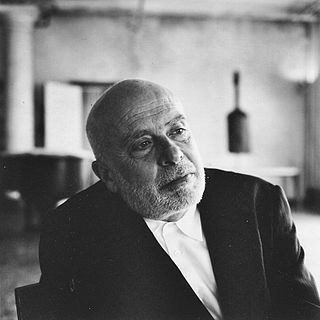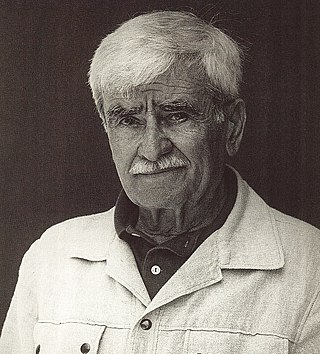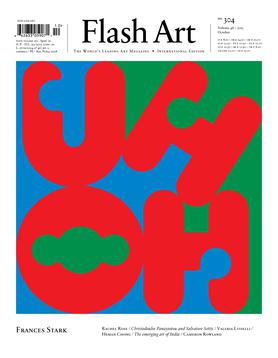Francesco Vezzoli (born 1971) is an Italian artist and filmmaker.
Contents

Francesco Vezzoli (born 1971) is an Italian artist and filmmaker.

Vezzoli studied at the Central Saint Martins School of Art in London from 1992 to 1995. In his early works from 1994 to 1996, he reenvisioned twentieth-century masterpieces by Mark Rothko and Josef Albers as modest-sized hand stitched petit point embroideries. Upon his return to Italy, Vezzoli created his first series of films entitled An Embroidered Trilogy (1997–99). [1]
2000 Vezzoli shot the short film The Kiss (Let's play Dynasty) with Helmut Berger. In 2002 his films were the subject of a one-man exhibition at the New Museum in New York City curated by Dan Cameron. [2] The film Non-Love Meetings (2004) from the series Trilogy of Death (2004) presents a game show in which contestants display their talents in hopes of winning the love of such celebrities as actress Catherine Deneuve. [1] His Trailer for the Remake of Gore Vidal's Caligula (2005), featuring Courtney Love as the title character, along with Helen Mirren, Benicio del Toro, Milla Jovovich and Vidal himself, was his entry at the 2005 Venice Biennale, when he and Giuseppe Penone represented Italy. The film was also screened as part of the 2006 Whitney Biennial. [3]
In 2007 Vezzoli was again included in the Venice Biennale in the Italian pavilion with his video piece DEMOCRAZY starring Sharon Stone and the French philosopher Bernard-Henri Levy as a pair of U.S. presidential candidates. That same year, he staged Luigi Pirandello's Right You Are (If You Think You Are) at the Solomon R. Guggenheim Museum, [4] [5] starring Abigail Breslin, Cate Blanchett and Dianne Wiest. On 14 November 2009 Vezzoli organised a performance where Lady Gaga performed her song Speechless on a pink Steinway & Sons piano decorated with painted-on butterflies while ballet dancers from the Bolshoi Theatre, danced alongside.
In his work, Vezzoli is often compared to Jeff Koons, Ashley Bickerton, Cindy Sherman and Haim Steinbach. [6]
On 25 November 2013 "The Church of Vezzoli" at MoMA PS1 in New York, one section of his three part retrospective "The Trinity", was cancelled after the church he arranged to buy in the town of Montegiordano for deployment in the exhibition is remanded in Italy prior to its leaving the country for the United States. [7]

Vezzoli's work has been exhibited at many institutions including Castello di Rivoli Museo d'Arte Contemporanea, Turin (2002); Fondazione Prada, Milan (2004 and 2005); Museu Serralves, Porto (2005); Le Consortium, Dijon (2006); Tate Modern, London (2006); Moderna Museet, Stockholm (2009–2010); Kunsthalle Wien (2009); the Garage Center for Contemporary Culture, Moscow (2010); and the MAXXI – National Museum of the 21st Century Arts, Rome (2013). His work has also been included in major group exhibitions like the Istanbul Bienali (1999), Liverpool Biennial (2002), São Paulo Bienal (2004), Whitney Biennial (2006), Performa 07 and Performa 15. [1] The Almine Rech gallery devoted two exhibitions to the artist : Francesco Vezzoli in Paris (2018) and Francesco Vezzoli's Eternal Kiss in London (2015)

Piero Manzoni di Chiosca e Poggiolo, better known as Piero Manzoni was an Italian artist best known for his ironic approach to avant-garde art. Often compared to the work of Yves Klein, his own work anticipated, and directly influenced, the work of a generation of younger Italian artists brought together by the critic Germano Celant in the first Arte Povera exhibition held in Genoa, 1967. Manzoni is most famous for a series of artworks that call into question the nature of the art object, directly prefiguring Conceptual Art. His work eschews normal artist's materials, instead using everything from rabbit fur to human excrement in order to "tap mythological sources and to realize authentic and universal values".

Arte Povera was an art movement that took place between the end of the 1960s and the beginning of the 1970s in major cities throughout Italy and above all in Turin. Other cities where the movement was also important are Milan, Rome, Genoa, Venice, Naples and Bologna. The term was coined by Italian art critic Germano Celant in 1967 and introduced in Italy during the period of upheaval at the end of the 1960s, when artists were taking a radical stance. Artists began attacking the values of established institutions of government, industry, and culture.

Jannis Kounellis was a Greek Italian artist based in Rome. A key figure associated with Arte Povera, he studied at the Accademia di Belle Arti in Rome.

Francesco Clemente is an Italian contemporary artist and book publisher. He has lived and worked at various times in Italy, India and New York City. Some of his work is influenced by the traditional art and culture of India. He has worked in various artistic media including drawing, fresco, graphics, mosaic, oils and sculpture. He was among the principal figures in the Italian Transavanguardia movement of the 1980s, which was characterized by a rejection of Formalism and conceptual art and a return to figurative art and Symbolism. He was the co-publisher of Hanuman Books from 1986 to 1993.
Germano Celant was an Italian art historian, critic, and curator who coined the term "Arte Povera" in the 1967 Flash Art piece "Appunti Per Una Guerriglia", which would become the manifesto for the Arte Povera artistic and political movement. He wrote many articles and books on the subject.

Mario Merz was an Italian artist, and husband of Marisa Merz.

Domenico "Mimmo" Rotella was an Italian artist considered an important figure in post-war European art. Best known for his works of décollage and psychogeographics, made from torn advertising posters. He was associated to the Ultra-Lettrists an offshoot of Lettrism and later was a member of the Nouveau Réalisme, founded in 1960 by the art critic Pierre Restany.

Alberto Burri was an Italian visual artist, painter, sculptor, and physician based in Città di Castello. He is associated with the matterism of the European informal art movement and described his style as a polymaterialist. He had connections with Lucio Fontana's spatialism and, with Antoni Tàpies, an influence on the revival of the art of post-war assembly in the United States as in Europe.

RoseLee Goldberg is an American-based art historian, author, critic and curator of performance art. She is most well known as being the founder and director of Performa, a performance art organisation. She is also currently a Clinical Associate Professor of Arts Administration at New York University.

Flash Art is a contemporary art magazine, and an Italian and international publishing house. Originally published bilingually, both in Italian and in English, since 1978 is published in two separate editions, Flash Art Italia (Italian) and Flash Art International (English). Since September 2020, the magazine is seasonal, and said editions are published four times a year.
Jesper Just is a Danish artist, who lives and works in New York. From 1997 to 2003, he studied at the Royal Danish Academy of Fine Arts.
Giuseppe Gabellone is an Italian artist who works in sculpture and photography. He lives and works in Paris.
Francesco Somaini was an Italian sculptor.
Giulio Paolini is an Italian artist associated with both Arte Povera and Conceptual Art.
Paolo Canevari is an Italian contemporary artist. He lives and works in New York City. Canevari presents highly recognizable, commonplace symbols in order to comment on such concept as religion, the urban myths of happiness or the major principles behind creation and destruction.

Fondazione Prada, co-chaired by Miuccia Prada and Patrizio Bertelli since 1995, is an institution dedicated to contemporary art and culture. From 1993 to 2010, the Fondazione has organised 24 solo shows at its exhibition spaces in Milan, conceived as dialogues with acclaimed contemporary artists. In 2015, the Fondazione Prada opened a new, permanent facility in Milan.
Gianni Piacentino is an Italian artist known for his sculpture and painting inspired by motorcycles, automobiles and planes.
Performa is a non-profit arts organization well-known for the Performa Biennial, a festival of performance art that happens every two years in various venues and institutions in New York City. Performa was founded in 2004 by art historian and curator RoseLee Goldberg. Since 2005, Performa curators have included Charles Aubin, Defne Ayas, Tairone Bastien, Mark Beasley, Adrienne Edwards, Laura McLean-Ferris, Kathy Noble, Job Piston, and Lana Wilson. The organization commissions new works and tours performances premiered at the biennial. It also manages the work of choreographer and filmmaker Yvonne Rainer.
Lucy Raven is an American artist. Raven's work is multidisciplinary and includes moving image installations, photography, sound, animation and performative lectures.

Eliseo Mattiacci was an Italian sculptor.